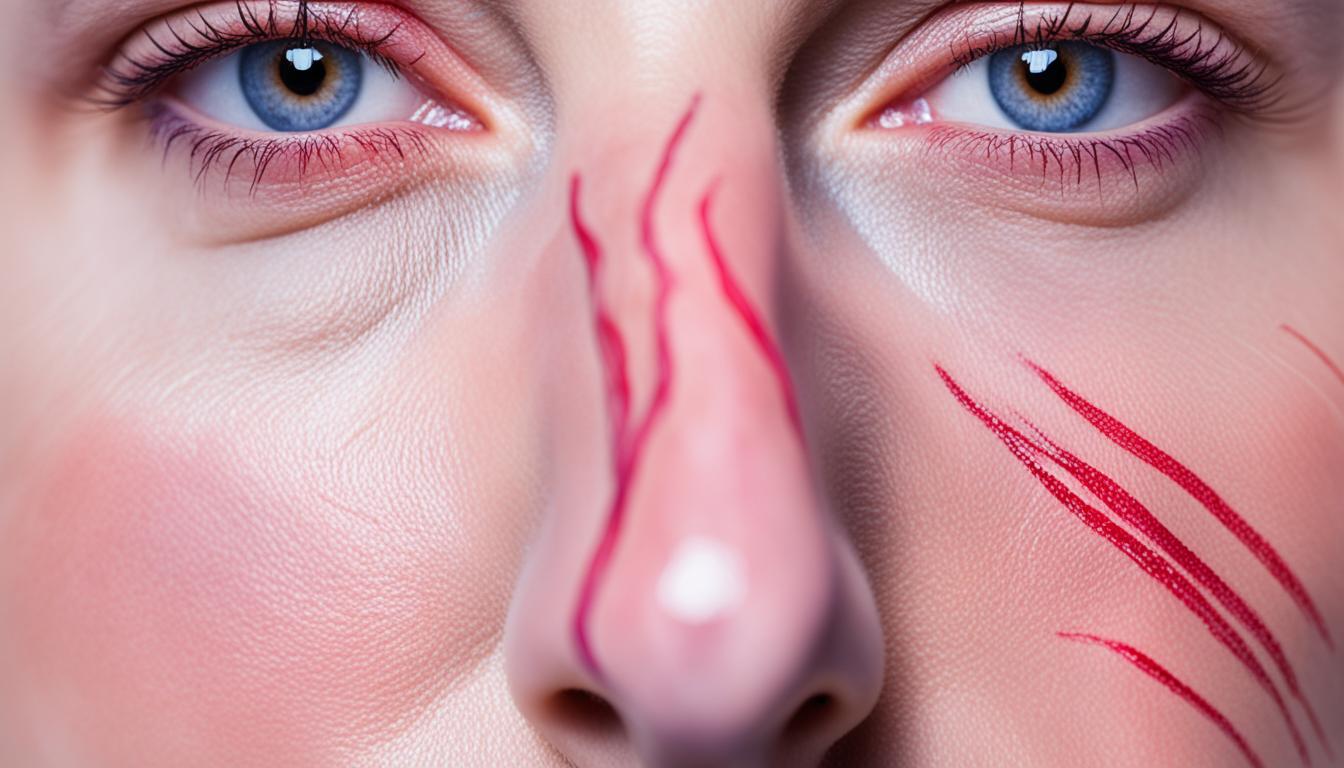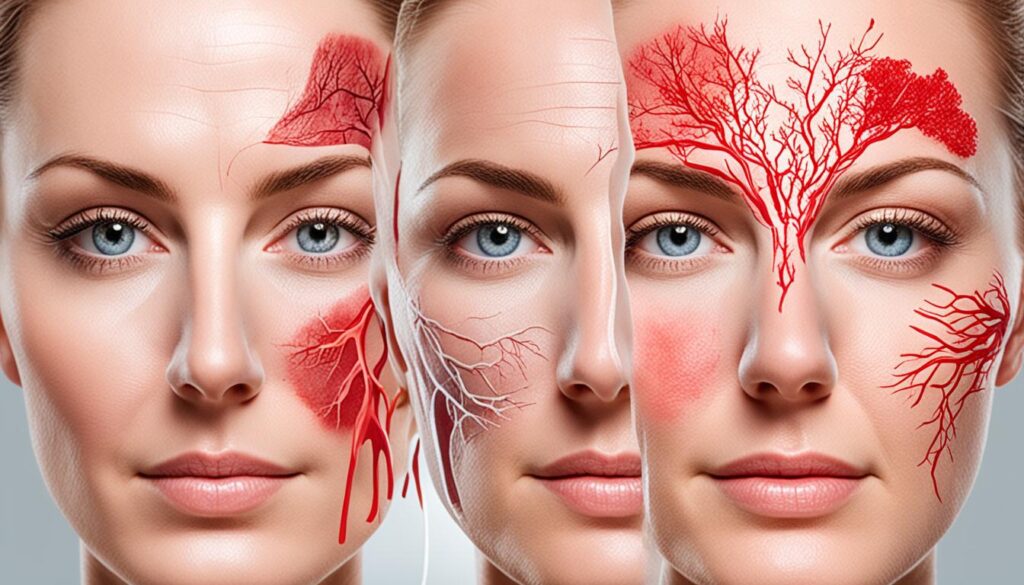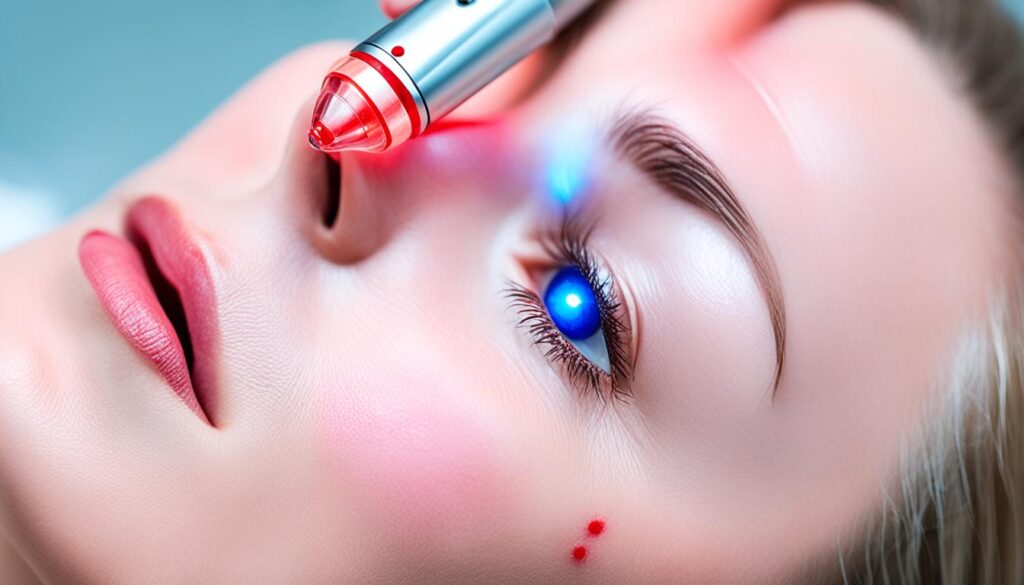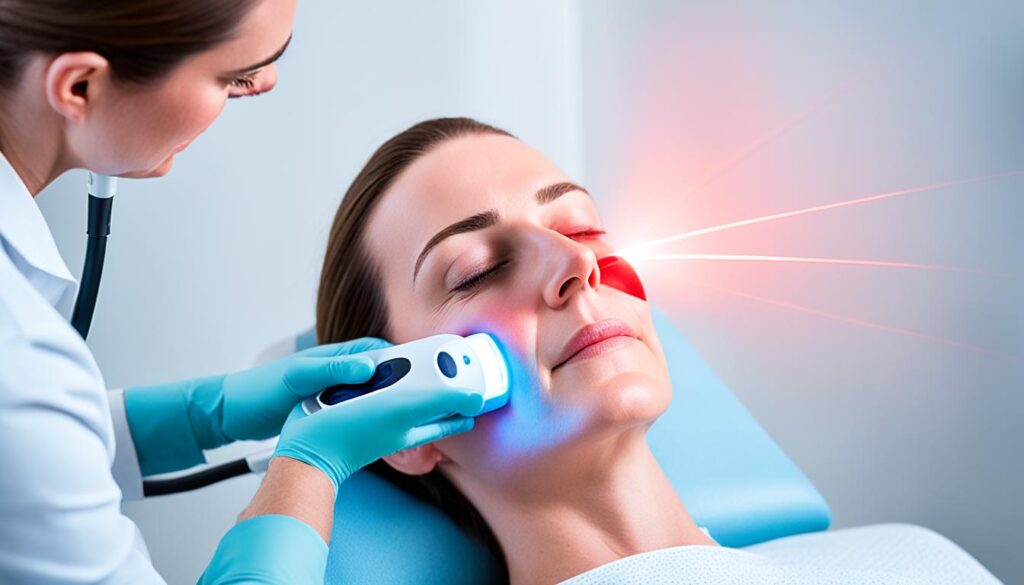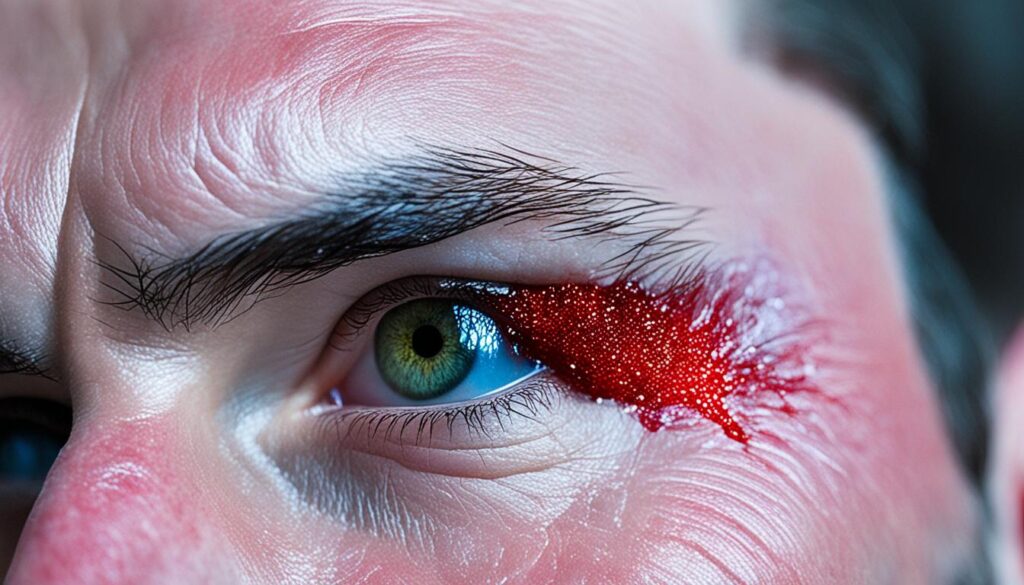Ever noticed broken capillaries on face, also known as spider veins? They’re quite common. But what causes them? Are they only due to aging, or are there other reasons?
Actually, several factors lead to these broken blood vessels. Genetics plays a big role, with most people inheriting spider veins from their family. Yet, there are more causes to understand.
Age, injuries, certain medicines, alcohol, and too much sun can make these veins appear. Also, health issues like rosacea or anything that harms blood vessels can be a factor too.
But are these broken blood vessels just a surface problem, or is there a deeper issue? And, what are our options for treating them?
Key Takeaways:
- Genetics, age, injuries, medications, alcohol consumption, and sun exposure can all contribute to the development of broken blood vessels on the face.
- Underlying health conditions that damage or scar blood vessels can also lead to the appearance of spider veins.
- Broken blood vessels on the face are common and can affect people of all ages, although they are more prevalent among the aged population.
- Treatment options for broken blood vessels range from natural remedies to medical treatments like laser therapy and IPL Photofacial treatment.
- Preventive measures, such as limiting sun exposure and avoiding extreme heat, can help reduce the risk of future spider veins.
Risk Factors for Broken Blood Vessels on the Face
Several risk factors can lead to broken blood vessels, known as spider veins, on the face. Knowing these aspects can guide choices for better skincare and health.
Genetics
Your genes largely influence the chance of getting spider veins on your face. About 90% of those with spider veins have family members with them too. So, a family history of these veins means you might get them too.
Age
As we grow older, the blood vessels in our face become weaker. This makes them easier to break. Spider veins might show up more as you age. Things like too much sun and certain lifestyle choices can make it worse.
Injury or Skin Damage
Any harm to your skin can up the chances of broken blood vessels. This includes small cuts, big bruises, or trauma. This can show up as spider veins on your face. Protect your face from injury and treat cuts right away to avoid this risk.
Medications
Certain drugs can also hike up the risk of spider veins. These include creams with steroid drugs, female hormone meds, and vasodilators. It’s crucial to talk to your doctor about how your drugs might affect your blood vessels.
Hormonal Changes During Pregnancy
When you’re pregnant, your hormones might cause spider veins. But, these usually go away after giving birth. These veins are not permanent and often disappear on their own.
Alcohol Consumption
Drinking too much alcohol might enlarge your blood vessels. This can increase the risk of spider veins, especially if you have fair skin. Cutting down on alcohol can lower this risk.
Sun Exposure
Exposing yourself to too much sun can hurt your skin and blood vessels. This makes you more likely to get spider veins. Always wear sunscreen and hats to protect your face from the sun.
Changes in Blood Pressure
Big and fast changes in your blood pressure can break blood vessels on your face. Things like strong sneezes or vomiting hard can increase pressure in your face. Always keep your blood pressure in check and be gentle with your face to avoid this.
Rosacea
Rosacea, a condition that makes your face red and your blood vessels visible, increases your risk for spider veins. If you have rosacea, manage it well and avoid things that trigger flare-ups. This can help keep spider veins away.
Other Underlying Medical Conditions
If you have health issues that hurt your blood vessels, you might be more at risk for spider veins. It’s crucial to treat these health conditions to lower your risk of getting broken blood vessels on your face.
Knowing the causes of broken blood vessels helps us avoid getting spider veins. While we can’t change some things like genetics or getting older, we can control how much sun we get and how much alcohol we drink. By managing these risks, we can have healthier skin and lessen the chances of getting spider veins on our face.
Diagnosis and Treatment Options for Broken Blood Vessels on the Face
Finding broken blood vessels on the face starts with looking at them closely. A healthcare pro will check the size and where they are. This helps pick the right treatment.
The way to treat these vessels depends on the person. Your health and what you want matter. There’s a range of ways to tackle spider veins, like:
- Laser therapy: Lasers are used in this simple, outpatient treatment. They heat the veins to make them fade. It’s great for small veins but might need a few tries for the bigger ones. You can keep going with your day right after.
- Intense pulsed light (IPL) therapy: This type, IPL, uses different light waves. Like lasers, it zaps veins, making them less visible. You could need a couple of visits for the best outcome.
- Thermocoagulation: A doctor also can use radio waves to treat these veins, in a method called thermocoagulation. They close off the vein using a small needle. Your body then gets rid of it, and your vein looks better.
- Microphlebectomy: Sometimes, cutting out the veins, called microphlebectomy, is the way to go. It’s done with tiny cuts and is more for serious cases or when other treatments fail.
Remember, not all options work for everyone. Your healthcare provider will suggest what’s best for you. They look at your veins’ size and place, along with your general health and goals. Then they recommend the most fitting plan.
Laser Therapy for Broken Blood Vessels on the Face
Laser therapy is a noninvasive and effective way to treat broken blood vessels on the face. It uses laser light to heat and eliminate spider veins over time.
The laser light finds the hemoglobin in the capillaries, which leads to their removal. It does this without harming the nearby skin.
For those with small veins, laser therapy is usually quick and successful. But, bigger veins might need more treatments to clear up. A talk with a healthcare expert can help figure out the best plan for you.
Check if your skin type is right for laser treatment. Specialists like dermatologists can let you know if laser therapy is a match.
After laser therapy, you might feel a bit of heat or irritation which is normal. Sometimes, you might see darker spots on the treated area but these usually fade over time.
To keep your skin in top shape post-treatment, shield it from the sun. UV rays can make new spider veins show up. Using sunscreen and avoiding excess sun will help.
In brief, laser therapy effectively removes broken blood vessels from your face. It’s safe and targets only the problem veins. If you’re thinking about it, talking to a healthcare provider is a smart choice for personalized advice.
Intense Pulsed Light (IPL) Therapy for Broken Blood Vessels on the Face
Intense pulsed light (IPL) therapy is a noninvasive way to treat broken capillaries on the face. It works like a laser but with a wider range of light. This light damages the blood vessels, reducing their look.
IPL is a common option for fixing broken capillaries safely and quickly. People often see better skin after just a couple of sessions. But, to fully clear the capillaries, you might need three or more sessions.
Besides capillaries, IPL can help with sun damage, rosacea, and more. It’s a versatile treatment for skin problems on many parts of the body.
IPL can do more than fix capillaries. It can smooth out skin, lessen wrinkles, and remove hair. IPL also helps with rosacea, acne, and sun damage.
Still, IPL might not be best for big, raised veins on the legs. Those might need a different kind of laser treatment. And, it’s usually fine after the procedure.
For upkeep, you might need touch-up IPL or laser treatments every year or two. These help prevent broken capillaries from coming back. Treatment every four months can also work after the first sessions.
After IPL, most people can go back to work right away. Any redness goes away soon, and spots might look darker before flaking off. It’s a quick recovery for most.
IPL is usually safe and has few temporary side effects. Still, always talk to a doctor before starting IPL. They can check if it’s the right choice for you.
40% OFF IPL & Fraxel Special–Ends Sept 15th
Offer valid thru Sept 15th, 2021
IPL is a great way to fix capillaries and other skin issues safely. It makes the skin look better by reducing capillaries, lines, and spots. With its many uses, IPL has become a top pick for skin treatments.
Thermocoagulation for Broken Blood Vessels on the Face
Thermocoagulation is great for fixing broken blood vessels on the face. It uses radio waves to gently heat and harm the veins. This method is safe and gives a lasting solution with the ThermaVein® machine.
This treatment seals the vein with microwave heat. It kills thin veins, making them vanish for good. It’s mainly for facial veins but also works on other body veins when needed.
Thermocoagulation is quick and effective. Sessions take about 45 minutes, from start to finish. It makes the veins fade right away, getting rid of the problem fast.
The risks with thermocoagulation are very low. You might see some small scabs, bruises, or tiny red marks for a bit. Yet, it’s generally safe with no serious issues.
Good aftercare is key for the best results. After treatment, avoid using makeup for 48 hours. Also, put aloe vera and sunscreen on for skin protection. These steps help the skin heal well and avoid problems.
The price for thermocoagulation starts at £300. This includes a £100 consultation and a £200 treatment. You might need more sessions, each costing £200. For the best effect, come back within 6 months of your first treatment.
Home Remedies for Broken Blood Vessels on the Face
Laser therapy and IPL are treatments experts use to reduce broken blood vessels on the face. But, some people like to try home remedies first. They might not work as well as medical treatments, but they can help a bit.
You can easily try cold therapy at home. Use a cool compress or a skin cooling tool to shrink the blood vessels and lessen redness. Another option is a bag of frozen veggies covered with a cloth. Put it on your face for a few minutes.
Witch hazel is a natural option that might help. It calms the skin and reduces redness with its anti-inflammatory properties. You can put witch hazel on with a cotton pad or mix it with water and spray it on your face.
Aloe vera is well-known for its calming effects. Pure aloe vera gel can help with inflammation and redness. Be sure to pick a gel that’s pure and doesn’t have any extra stuff in it.
Cleansing your face in the right way can also make a difference. Use cold or warm water with a gentle cleanser. Stay away from hot water, as it can make things worse. Always keep your skin clean and balanced.
Disclaimer: These home remedies may offer some help, but they’re not as strong as medical treatments. Talking to a healthcare pro is key to finding the best treatment for you.
Preventing Broken Blood Vessels on the Face
Preventing broken blood vessels on the face is largely about lowering the risk and keeping your skin healthy. You can do this by adding a few easy habits to your daily life. These habits will stop you from getting broken capillaries and keep your skin clear.
Avoiding Extreme Heat
Too much heat can make your blood vessels larger, which might lead to visible capillaries on the face. It’s best to stay away from long exposure to high temperatures, like saunas and hot baths. Also, don’t let heating tools touch your face too closely to avoid blood vessel expansion.
Protecting Against UV Light
Being in the sun too much can cause broken blood vessels on the face. To keep your skin safe, use sunscreen that’s strong and reapply it often. Wearing wide-brimmed hats and sunglasses helps protect your face more.
Avoiding Harsh Scrubbing
Don’t scrub your face too hard when you clean or exfoliate. Rough scrubbing can harm the tiny blood vessels. Use gentle products made for sensitive skin. They clean well without hurting the blood vessels.
Quitting Smoking
Smoking harms your skin and can lead to broken blood vessels. Quitting smoking, or staying away from secondhand smoke, can lower your chance of getting broken capillaries. Ask a healthcare pro for help in stopping smoking, if you need it.
Following these steps can reduce your chance of getting broken blood vessels on the face. But, if you already have them, see a doctor or skin expert for advice on what to do. They can guide you on the best treatments.
Remember, what’s good for one person’s skin might not be for someone else. For the best advice, always talk to a pro. They can help you figure out what’s right for you.
Summary and Conclusion
Broken blood vessels on the face are often called spider veins or broken capillaries. They bother many people because they affect the look of their face. Luckily, there are ways to deal with them.
Laser treatment, like using Vbeam lasers, is a common choice. It is not invasive. Patients usually need several sessions, and these sessions are weeks apart. After 2-5 treatments, you can see a big change. The amount of broken veins can lower by 50-75%. This change can last for a long time, even up to two years.
After laser treatment, some may notice that their face swells or looks red. This is normal but should go away soon. To help with this, using cold packs or Arnica Montana can make things better. It’s also good to stay away from alcohol, direct sunlight, and aspirin for a while to help your skin heal.
In the end, if you want to fix the broken blood vessels on your face, you have many ways to do it. Talking with a healthcare professional or dermatologist is a smart step. They can help choose the best option for you. With treatments like laser or other medical options, you can make your face look better. You can reduce the look of those broken capillaries and get back smooth skin.
